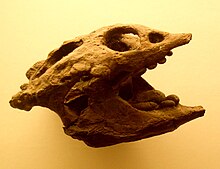Placodontia
| Placodonts | |
|---|---|

| |
| Placodus, type genus | |
| Scientific classification | |
| Domain: | Eukaryota |
| Kingdom: | Animalia |
| Phylum: | Chordata |
| Class: | Reptilia |
| Superorder: | †Sauropterygia |
| Clade: | †Placodontiformes |
| Order: | †Placodontia Cope, 1871 |
| Subgroups | |
| |
Placodonts ("
The first specimen was discovered in 1830. They have been found throughout central Europe, North Africa, the Middle East and China.
Palaeobiology

The earliest forms, like
Because of their dense bone and heavy armour plating, these creatures would have been too heavy to float in the ocean and would have used a lot of energy to reach the water surface. For this reason, and because of the type of sediment found accompanying their fossils, it is suggested that they lived in shallow waters and not in deep oceans.
Their diet consisted of marine bivalves, brachiopods, and other invertebrates. They were notable for their large, flat, often protruding teeth, which they used to crush the molluscs and brachiopods that they hunted on the sea bed (another way in which they were similar to walruses). The palate teeth were adapted for this durophagous diet, being extremely thick and large enough to crush thick shell.
Henodus, however, differs from other placodonts in having developed unique baleen-like denticles, which alongside features of the hyoid and jaw musculature suggest that it was a filter feeder.[1][2] Recent comparisons to Atopodentatus suggest that it was a herbivore as well, bearing a similar broad jaw shape, albeit it obtained plant matter through filter-feeding it from the substrates.[3] The group was once believed to be restricted to the western Tethys, but the discovery of Sinocyamodus xinpuensis in China overturned this view.[4]



Classification
- Class Reptilia
- Superorder Sauropterygia
- Order Placodontia
- Genus Atopodentatus?
- Genus Pararcus
- Superfamily Placodontoidea
- Family Paraplacodontidae
- Genus Paraplacodus
- Family Placodontidae
- Genus Placodus
- Family
- Superfamily Cyamodontoidea
- Genus Sinocyamodus
- Genus Psephosauriscus
- Genus Psephosaurus
- Family Henodontidae
- Genus Henodus
- Genus Parahenodus[5]
- Family Cyamodontidae
- Genus Cyamodus
- Genus Protenodontosaurus
- Family Placochelyidae
- Genus Glyphoderma
- Genus Placochelys
- Genus Psephosauriscus
- Genus Psephochelys
- Genus Psephoderma
- Order Placodontia
- Superorder Sauropterygia
Additionally, the name Placodontiformes was erected for the clade that includes Palatodonta and Placodontia. Palatodonta, from the early Middle Triassic of the Netherlands, was a marine sauropterygian that was very similar to placodonts, but Palatodonta has teeth that are small and pointed instead of broad and flat.
The clade Helveticosauroidea was previously considered to be a basal superfamily of placodonts with the sole member Helveticosaurus. However, it is now thought that Helveticosaurus was not a placodont but possibly an unusual member of the Archosauromorpha.[citation needed]
Phylogeny
The cladogram below follows the result found by Rainer Schoch and Hans-Dieter Sues in 2015.[6]
| Sauria | |
| (=Archelosauria) |
References
Sources
- Bardet, N. (1995). "Evolution et extinction des reptiles marins au cours du Mesozoique". Palaeovertebrata (24): 177–283.
- Huene, F. von (1933). "Die Placodontier. 4. Zur Lebensweise und Verwandtschaft von Placodus". Abhandlungen der Senckenbergischen Naturforschenden Gesellschaft (in German) (38): 365–382.
- Mazin, J.-M. (1986). "Negevodus ramonensis n. g. n. sp., un nouveau placodonte du Trias moyen du Negev (Israel)". 302. Comptes Rendus de l'Académie des Sciences, Série II: 927–929.
{{cite journal}}: Cite journal requires|journal=(help) - Mazin, J.-M. (1989). "La denture et la région palatine des Placodontia (Reptilia, Trias). Implications phylogénétiques". Geobios (in French). 22 (6): 725–734. .
- Mazin, J.-M. & Pinna, G. (1993). "Palaeoecology of the armoured placodonts". Paleontologia Lombarda. New Series. 2: 83–91.
- Nosotti, S. & Pinna, G. (1993a). "Cyamodus kuhn-schnyderi n. sp., nouvelle espèce de Cyamodontidae (Reptilia, Placodontia) du Muschelkalk supérieur allemand". Comptes Rendus de l'Académie des Sciences, Série II. 317: 847–850.
- Nosotti, S. & Pinna, G. (1993b). "New data on placodont skull anatomy". Paleontologia Lombarda. New Series. 2: 109–114.
- S2CID 111331431.
- Peyer, B. & Kuhn-Schnyder, E. (1955). "Placodontia". In Piveteau, J. (ed.). Traite de Paleontologie. Vol. V. Paris: Masson et Cie. pp. 459–468.
- Rieppel, O. (1995). "The genus Placodus: systematics, morphology, paleobiogeography and paleobiology". Fieldiana Geology. New Series. 31: 1–44.
- Rieppel, O. C. & Zanon, R. T. (1997). "The interrelationships of Placodontia" (PDF). Historical Biology. 12 (3–4): 211–227. .
- Rieppel, O. C. (2000). "Paraplacodus and the phylogeny of the Placodontia (Reptilia: Sauropterygia)". Zoological Journal of the Linnean Society. 130 (4): 635–659. .
- Sues, H.-D. (1987). "On the skull of Placodus gigas and the relationships of the Placodontia". Journal of Vertebrate Paleontology. 7 (2): 138–144. .
- Westphal, F. (1976). "The dermal armour of some Triassic placodont reptiles". In Bellairs, A. d’A. & Cox, C. B. (eds.). Morphology and Biology of Reptiles. London: Academic Press.
- Zanon, R. T. (1989). "Paraplacodus and the diapsid origin of Placodontia". Journal of Vertebrate Paleontology. 9: 47A. .
- Zanon, R. T. (1991). "Negevodus ramonensis Mazin, 1986, reinterpreted as a temnospondyl, not a placodont". Journal of Vertebrate Paleontology. 11 (4): 515–518. .


